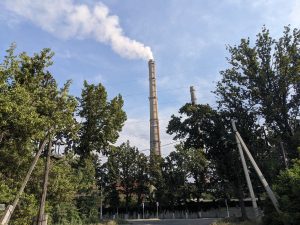After a massive pre-dawn explosion on February 2 at the Bishkek Thermal Power Plant, Kyrgyz President Sadyr Japarov pledged to order a “complete modernization” of the plant, which he described as “older than me.”
Five people were injured, three of them seriously, in the explosion, which the Ministry of Emergency Situations said occurred in a coal mill near the plant’s 14th boiler. The power plant is what’s known as a combined heat and power plant, as it produces both electricity and heat by burning coal. The large explosion and ensuring fire destroyed the plant’s roof and plunged parts of the Kyrgyz capital into darkness, while leaving most of the city without heat and hot water for almost a day.
Once again, Bishkek’s problematic power plant is in the news.
Built in 1961, the plant underwent what was supposed to be a major update a decade ago when Kyrgyzstan settled a $386 million loan agreement with China’s Export-Import Bank. A Chinese company, Tebian Electric Apparatus Stock Co. Ltd. (TBEA), was granted the contract to construct two new 150 MW units at the plant. The project was completed in August 2017 but the following winter, in January 2018, the power plant failed spectacularly during a cold snap.
The fallout of the 2018 breakdown included the jailing of two former prime ministers, accused of corruption during the modernization project, and touched of the deterioration of the relationship between then-President Sooronbay Jeenbekov and his predecessor, Almazbek Atambeyev, once very close allies.
The Bishkek Thermal Power Plant provides around 15 percent of Kyrgyzstan’s electricity, making its continued weakness a national problem. Since late 2020, there has been repeated chatter about modernizing the power plant and converting from coal to natural gas to heat its boilers. In June 2023, Minister of Energy of Kyrgyzstan Taalaybek Ibrayev told a parliamentary committee that such a conversion would cost around 4 billion Kyrgyz som ($45 million), plus the cost of gas. At the same time, the minister announced the conclusion of a contract with a Kazakh company, Shabyrkul, for the import of 550,000 tons of coal to feed the plant at a cost of 3.26 billion som. A deputy asked why local Kara-Kechi coal coal couldn’t be used, to which the minister reportedly replied, “Burning Kara-Kechi coal will require the use of additional gas and fuel oil, and this will be more expensive.”
After the February 2 explosion, Japarov suggested that this coal switch may have been the problem in his interview with Kabar.
“I’m not an expert in this matter, but I still think that perhaps they did not take into account the power of this coal. They heated the thermal power plant as if they were using Kara-Kechi coal, which is weaker. I think maybe this was the cause of the explosion,” Japarov said.
He referred to the Kazakh coal as “clean coal” and cited it as responsible for there being “less dust” in the capital this year. Bishkek is plagued by smog, especially in the winter when the coal-fired power plant is working overtime to keep the city warm. The city routinely has unhealthy air quality.
Japarov cited the $386 million loan, which was spent on adding new units to the plant rather than repairing or modernizing the old ones, saying that for that much money “the old CHP [Combined Heating and Power plant] could have been completely repaired without doing anything.”
The Kyrgyz president said he would order the full modernization of the plant, and that funds would have to be found. Maybe there will be a Chinese loan on offer? Buyer beware.

































